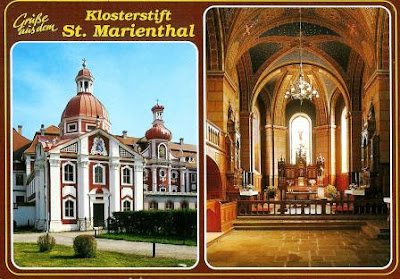After so many swiss card, now i've this bunch of german cards.
© Schöning GmbH & Co. KG
DE-2229784, sent by Holger.
This a nice view of the Historic Market Place in Hildesheim.
From left to right, the buildings on the card are Bakers' Guild Hall, Butchers' Guild Hall, Old Tavern, Rococo House, Weavers' Guild Hall and Market Fountain in the
foreground.
The present market place of Hildesheim was laid out at the beginning of the 13th
century. Several impressive
half-timbered houses were built in the Market Place. The Butchers' Guild
Hall was the tallest and the most famous of them.
During World War II, Hildesheim
suffered severe bomb damage. On 22 March 1945 the
half-timbered houses of the market place were destroyed by incendiary bombs. In the 1950s the houses which had been completely destroyed were replaced by
concrete buildings with flat roofs. The Butchers' Guild Hall was replaced by a hotel which was built from 1962-64.
At the beginning of the 1980s, the hotel in the Market Place went bankrupt. On this occasion, the City Council decided to tear down the concrete buildings
and to reconstruct the historic Market Place of Hildesheim in the original
style.
The reconstruction was
started in the Western part of the Market Place in 1983. Many inhabitants of
Hildesheim donated money for the project and provided old photos and drawings.
In some cases, old construction plans were preserved. The first houses, rebuilt
in the original style, were inaugurated on 23 March 1986.Afterwards, the
Eastern part of the Market place was rebuilt and the Market Fountain dating from
1542 was restored. A large public garage was built under the Market place as
well. The Butchers' Guild Hall and the smaller adjoining Bakers' Guild Hall were
the last buildings to be reconstructed. They were inaugurated in December 1989. - in: wikipedia
© Herst. u. Verlag Schöning & Co. + Gebr Schmidt
DE-2373397, sent by Nico.
St. Marienthal Abbey, is a Cistercian nunnery in Saxon Upper Lusatia, located to the south of Ostritz. The abbey is the oldest nunnery of the Cistercian Order in Germany to have maintained unbroken occupation of its house since its foundation.
The abbey was founded in 1234.
During World War II the buildings were used as a military hospital. In 1945 the retreating German forces wanted to blow up the abbey to hinder the advance of the Russians, but the nuns refused to leave, and the building was spared. - in: wikipedia
DE-2265704, sent by Daniela.
Neuwerk is a Wadden Sea island on the German North Sea coast.
During low tide the island can be reached on foot or by horse carriages from Cuxhaven, at other times by ship.
The smaller islands Scharhörn and Nigehörn are bird sanctuaries, closed to the public. All three islands and the Wadden Sea around them form the Hamburg Wadden Sea National Park. - in: wikipedia
© Schöning GmbH & Co. KG
DE-2392895, sent by Daja.
The lake-dwelling museum of Unteruhldingen is situated on the Lake Constance in
the South-East of Germany, on the northern shore of an international lake that
borders Switzerland in the South and Austria in the East. It shows 20 Neolithic
and Bronze Age houses (4000 – 850 BC), includes an archaeological research
institute and a museum building on shore for temporary and regular exhibitions. - in: http://www.pfahlbauten.com/infos/press-media-articles.html
IT-234801, sent by Lea.
The ID of official is italian but the card is german, showing the Kappl Pilgrimage Church, a few kms from Waldsassen, in the Upper Palatinate, Bavaria. This is a round baroque church built between 1685 - 1689.



.jpg)

.jpg)

.jpg)

.jpg)

.jpg)










.jpg)

.jpg)


.jpg)

.jpg)

.jpg)

.jpg)



.jpg)











